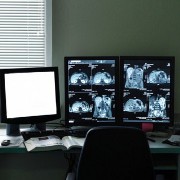 Photo: Getty Images
Photo: Getty Images
When scar-like tissue develops instead of normal bone, this is a disorder known as fibrous dysplasia. This tissue will expand as the bone grows, causing the bone to weaken. This can then cause the bone to become deformed and therefore more likely to fracture in the event of a fall or injury.
When one is affected with a mild case of this bone disorder, it may not always create signs or symptoms. The more serious cases can contribute to bone pain and deformity, usually beginning before the individual is 15 years of age.
No exact cause for fibrous dysplasia is known at this time, and as there is no cure, the emphasis of treatment is to relieve the signs and symptoms.
Although fibrous dysplasia can occur in any bone in the body, most people afflicted with this condition have only one bone affected. When this disease affects just one bone, it is referred to as monostotic fibrous dysplasia. When it affects more than one bone, it is called polystotic fibrous dysplasia.
The bones in the body that are usually affected by this condition include the thighbone, the shinbone, the bones in the pelvic region, the ribs, the skull, bones in the face, and the upper arm bone.
If fibrous dysplasia is affecting more than one bone in the body, the symptoms may include bone pain, difficulty walking, deformities in the bone(s), and fractures. Although rare, it can cause abnormalities in the glands of the endocrine system that are responsible for producing hormones, which can contribute to an early onset of puberty, problems with the thyroid glands, or discoloration of the skin.
Fibrous dysplasia develops before birth and has been linked to a gene mutation that affects the cells produced by the bones. While the cause for such mutation is not known or understood, it is not an inherited disease, nor one that you can pass on to your children.
Since bones are living tissue, they are always actively at work, even after you stop growing. As they work to remodel themselves, bone cells known as osteoclasts work to tear down the old bone while osteoblasts work to rebuild new bone. It’s a constant process. When fibrous dysplasia is present, this normal process is disrupted, and the old bone breaks down much quicker, replacing the normal bone tissue with the softer, fibrous tissue, thereby weakening the bone structure.
The complications of fibrous dysplasia include bone fractures, deformity of the bone, changes in hearing and vision (as the eyes and the ears may be near the affected bone, although this complication is rare), arthritis, and, in rare cases, cancer can develop in the affected bone.
When visiting a specialist about this condition, the basic diagnostic tests used to confirm the disorder and to determine its extent may include imaging tests, such as a CT scan or MRI scan. The doctor might also request a bone scan or bone biopsy to surgically remove a part of the affected bone for further inspection and evaluation.
To treat this condition, medications known as bisphosphonates are typically used to inhibit the breakdown of the bone and to increase bone density. These medicines can also be used to reduce the bone pain, and, in some instances, improve the bone formation.
Surgery may be an option when a deformity needs to be corrected or a fracture needs to be fixed. It may also be considered if there is pressure on a nerve that is causing pain or to remove an affected area of the bone that is causing great difficulty for the individual.
In addition to medical help and support, another means of defense is to learn all you can about fibrous dysplasia and to connect with others who are dealing with the same situation. Find out from your physician if there are support groups in your area.
(Information for this article was found at http://www.mayoclinic.com/health/fibrous-dysplasia/DS00991)






Add a CommentComments
There are no comments yet. Be the first one and get the conversation started!